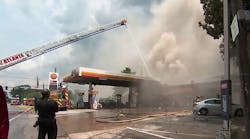Many fire departments assign a team of firefighters to roof operations at structural fires. When news cameras are on scene, firefighters can be seen working hard atop the burning building’s roof. Bystanders may wonder just what these firefighters are doing up there. Is it safe to be above the fire? Are they contributing to the rapid extinguishment of the fire? Let’s take a look at what firefighters are doing on the flat roofs of burning buildings.
Lightweight or dimensional
One of the most important pieces of information that must be determined at a fire in a flat-roof building is what the building is made of. Specifically, is the building built of conventional dimensional lumber or some type of lightweight construction? Lightweight construction is prone to early failure when the elements of the truss are heated or begin burning, so we must ensure that we don’t put firefighters on lightweight roofs when they are involved in fire or exposed to high heat. Once it is determined that the roof is constructed of wooden joists and is not heavily involved in fire, we know that we can dispatch firefighters to that area to work. Also remember that some of the issues discussed here apply when the fire is directly under the roof, such as a top floor or attic fire.
Access
There are many routes that a firefighter can take to a roof. Some roofs are easily laddered with both portable and aerial ladders. Some buildings have fire escapes that serve every floor and also have a gooseneck ladder to the roof. Sometimes firefighters can get to the roof of a burning building by climbing the stairway of the attached adjacent building and then stepping over the parapet wall onto the roof of the involved building.
If you are attempting to use a ladder to get to the roof, you must first select the correct ladder. Obviously an aerial will reach most roofs, but portable ladders must be selected carefully. When a portable ladder is used, remember that the tip of the ladder should be four or five rungs above the roof. This makes for easier and safer climbing onto and off of the roof. The same rule applies to aerials. It also allows firefighters to quickly visually locate the ladder from anywhere on the roof.
When using a fire escape, it is not a good idea to use one that passes the fire apartment because the fire could vent out a window onto the fire escape and trap the firefighter on the roof or injure them.
Once you arrive at the roof, strike or sound the roof with a tool to determine if it is stable enough to hold your weight. Additionally, walk with the tool sounding continuously on the roof surface ahead of you so you can assess the stability of the roof as you move. Just because it was solid where you stepped off the ladder does not mean it is not weak elsewhere.
Tactics
One of the obvious tactics is vertical ventilation, which can be accomplished in several different ways. For a top-floor fire in a multi-story building, or a fire in the attic or cockloft directly under the roof, the roof can be cut to provide this ventilation. This is most often accomplished with a power saw, and there are several methods and sequences of cuts that work well. If cutting a roof to vent the area below, remember to push the ceiling down to allow the smoke, heat and gases to rise out of the fire area and up through the vent opening.
Another method of ventilating a flat-roof building is useful in buildings that have a roof bulkhead—a small structure above the roof that contains a stairway from the top floor. It is actually an extension of the public stairway that starts on the first floor, and when this door is opened, it ventilates the entire vertical stairway enclosure. This allows smoke and heat from a lower floor fire that has pushed out into the public hallway to rise up to the top and out the now opened door. One final point: Remember, a firefighter should never travel up the interior stairway of a burning building to reach the roof. Use one of the routes discussed earlier in this article instead.






